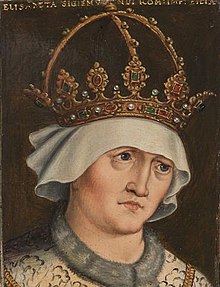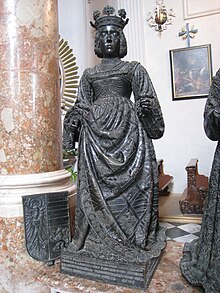Elisabeth of Luxembourg (1409–1442)
Elisabeth of Luxembourg (Hungarian Erzsébet , Croatian Elizabeta Luksemburška , Czech Alžběta Lucemburská ; born February 28, 1409 in Prague , † December 19, 1442 in Győr ) was the daughter of Emperor Sigismund from the House of Luxembourg and his second wife Barbara von Cilli . As wife of the future King Albert II. Was up to his death on October 27, 1439 Duchess of Austria on 19 April 1422, Queen of Hungary from December 18, 1437 (January 1, 1438 crowned in Székesfehérvár (Szekesfehervar)), Queen of Bohemia from December 27, 1437 (crowned June 29, 1438 in Prague) and Roman-German Queen from March 18, 1438 (never crowned). After the death of her husband (1439) she tried to secure the succession of her son Ladislaus Postumus to the throne in Bohemia and Hungary, but died after a two-year unsuccessful civil war.
Early life, marriage and offspring
Elisabeth of Luxemburg was betrothed to the Austrian Duke Albrecht V , who came from the House of Habsburg and was about 12 years older , on October 7, 1411, at the age of two . Her parents, however, often had quarrels with each other and around 1419 Elisabeth and her mother had to live in exile in the eastern Hungarian Puszta for a long time . On the other hand, she was the only surviving child of the Roman-German king and later emperor Sigismund and thus his presumptive heir. Probably not without previous pressure from Albrecht V on Sigismund, who was heavily indebted to him, Elisabeth finally married her long-term fiancé on April 19, 1422 in Vienna . As early as 1423 Sigismund announced his son-in-law Albrecht as his successor and handed over the administration of Moravia to him . During the 17 years of marriage, Elisabeth gave birth to four children, but the last son only after the death of her husband:
- Anna (April 12, 1432 - November 13, 1462), wife of Duke Wilhelm III since 1446 . of Saxony
- Georg (February 16, 1435 - February 16, 1435)
- Elisabeth (around 1437; † August 30, 1505), since 1454 the wife of the King of Poland, Casimir IV Jagiełło
- Ladislaus Postumus (February 22, 1440 - November 23, 1457), King of Bohemia and Hungary
After the death of Emperor Sigismund (December 9, 1437), Elisabeth's consort as Albrecht II was his successor as Roman-German king; he also ascended the throne of Hungary and Bohemia. Accordingly, Elisabeth became queen of the countries mentioned. From Bratislava she was independently politically active, sometimes at odds with the interests of her husband.
Fight for Ladislaus' succession to the throne and death
When Albrecht died early (October 27, 1439), Elisabeth was five months pregnant. The late king had determined in his will that the expected child, if it was to be a boy, would succeed him in the Duchy of Austria (Lower and Upper Austria) as well as in Hungary and Bohemia and that Duke Friedrich V (later the Roman-German King Friedrich IV. or Emperor Friedrich III. ) should become his guardian. The energetic Elisabeth first took over the reign in Hungary. However, many Magyar magnates, especially Johann Hunyadi , believed that Hungary needed a strong regent in view of the threat posed by the Ottomans and urged the 30-year-old Elisabeth in January 1440 to meet the only 15-year-old Polish King Władysław III. to marry. Convinced that she would give birth to a son, Elisabeth resolutely opposed these demands and was able to obtain a postponement of the marriage plans. She tried to prevent the Hungarian nobility from electing a king before the birth of her child, discussed with her followers, including her mother's relatives, the Count of Cilli , and planned to seize the crown of St. Stephen, which legitimized the king and was considered sacred .
With the theft of Krönungsinsignie from the vaults of Plintenburg ( Visegrád ) Elizabeth commissioned her maid Helene Kottanner that could accomplish in the night of 20 to 21 February 1440 with the support of a Hungarian nobleman, the company, which they in their memoirs reported . After a sleigh ride across the frozen Danube , the chambermaid brought the crown to Komorn . Soon afterwards, on February 22nd, the queen widow came to Komorn with her son Ladislaus, called Postumus (the next born). Despite this birth of a male descendant of Albrecht II, the opposing party prevailed that Władysław III. was elected King of Hungary by ambassadors of the Hungarian Diet on March 8th in Cracow .
Elisabeth went to Stuhlweissenburg with Ladislaus and had him crowned there on May 15, 1440 with the St. Stephen's crown by the Archbishop of Gran. When the imperial regalia were to be brought back to Visegrád, Elisabeth managed to keep the St. Stephen's crown by inserting a false crown into the sealed container. After Elizabeth supported the elevation of Dionysius Szechy as the new Archbishop of Gran and failed to take into account the expectations of the ambitious Bishop of Eger , Simon Rozgonyi , the latter became her bitterest enemy and called the Poles into the country. Władysław III, who has now arrived in the furnace. was crowned King of Hungary on July 15, 1440, after the real crown was no longer available, with the crown adorning the reliquary of St. Stephen in Stuhlweissenburg .
As a result, there was a civil war of several years in Hungary, in which Elisabeth was constantly confronted with money problems to cover the war costs. In Bohemia, too, a strong party of the Utraquists was opposed to the succession of their son Ladislaus. Did Elisabeth initially, contrary to the will of her deceased husband, have the Duke Albrecht VI. preferred as guardian of her son, so she approached after the coronation of Władysław III. Frederick IV of Habsburg, who was originally intended as guardian in the will, and who has meanwhile risen to the position of Roman-German King . She pledged the St. Stephen's Crown for 2500 ducats to Friedrich and handed over her son Ladislaus to him as guardian and in protective care. With the money she received, she recruited soldiers to fight against Władysław III. She was supported in her warlike efforts by Count Ulrich von Cilli , Bohemian mercenaries under the command of the nobleman Johann Giskra von Brandeis and the German citizens of the Upper Hungarian cities. However, on April 19, 1441, the Counts of Cilli concluded a settlement with the Jagiellonian and primarily only Johann Giskra continued the fight for Elisabeth.
On May 14, Bishop Simon Rozgonyi paid homage to the Polish king who was moving into Eger, his brother Stephan Rozgonyi also held the fortress of Pressburg occupied by King Wladyslaw, but the city itself, like Kaschau, remained on Elisabeth's side.
Finally, the cardinal legate Giuliano Cesarini mediated on behalf of Pope Eugene IV between the competitors since the summer of 1442 in order to put an end to the bloodshed and to enable a concentrated defense against the Turks. In November of the same year there was a meeting between Elisabeth and Władysław III in Győr , at which a balance was reached between them. But only three days after the Jagiellonian left, Elisabeth died suddenly and was buried in the basilica in Stuhlweissenburg. Władysław was suspected of having had her poisoned.
With Elisabeth's son Ladislaus, who died in 1457 at the age of only 17, the Albertine line of the Habsburgs also died out in the male line.
literature
- Constantin von Wurzbach : Habsburg, Elisabeth of Hungary . No. 66. In: Biographisches Lexikon des Kaiserthums Oesterreich . 6th part. Imperial and Royal Court and State Printing Office, Vienna 1860, p. 166 ( digital copy ).
- Franz von Krones: Elisabeth . In: Allgemeine Deutsche Biographie (ADB). Volume 6, Duncker & Humblot, Leipzig 1877, pp. 9-11.
- Hans Wagner: Elisabeth. In: New German Biography (NDB). Volume 4, Duncker & Humblot, Berlin 1959, ISBN 3-428-00185-0 , p. 441 f. ( Digitized version ).
- Elisabeth. In: Brigitte Hamann (Ed.): The Habsburgs . Ueberreuter, Vienna 1988, ISBN 3-8000-3247-3 , pp. 85-86.
Web links
Individual evidence
- ↑ Date of birth according to Article Elisabeth. In: Brigitte Hamann (Ed.): The Habsburgs. 1988, p. 85; in other books (e.g. Hans Wagner, in: NDB, vol. 4, p. 441) it is often only stated in general that Elisabeth was born around 1409.
- ^ Charles Cawley, Foundation for Medieval Genealogy, Medieval Lands, Austria [1]
- ↑ The wedding date April 19, 1422 is e.g. B. Hans Wagner (in: NDB, Vol. 4, p. 441); according to Richard Reifenscheid ( Albrecht II. In: Gerhard Hartmann, Karl Schnith (Ed.): Die Kaiser. 1996, ISBN 3-222-12421-3 , p. 463) the wedding took place on September 28, 1421 in Prague.
- ^ Franz Theuer : The robbery of the Stephanskrone. Eisenstadt 1994, ISBN 3-85374-242-4 , pp. 120-124.
| predecessor | Office | successor |
|---|---|---|
| Barbara from Cilli | Queen of Bohemia 1438–1439 |
Kunigunde von Sternberg |
| Barbara from Cilli | Queen of Hungary 1437–1439 |
Catherine of Podebrady |
| Albrecht |
Queen of Croatia 1439–1440 |
Vladislav I. |
| personal data | |
|---|---|
| SURNAME | Elisabeth of Luxembourg |
| ALTERNATIVE NAMES | Alžběta Lucemburská (Czech) |
| BRIEF DESCRIPTION | Daughter of Emperor Sigismund and his wife Barbara von Cilli |
| DATE OF BIRTH | February 28, 1409 |
| PLACE OF BIRTH | Prague |
| DATE OF DEATH | December 19, 1442 |
| Place of death | Győr |

